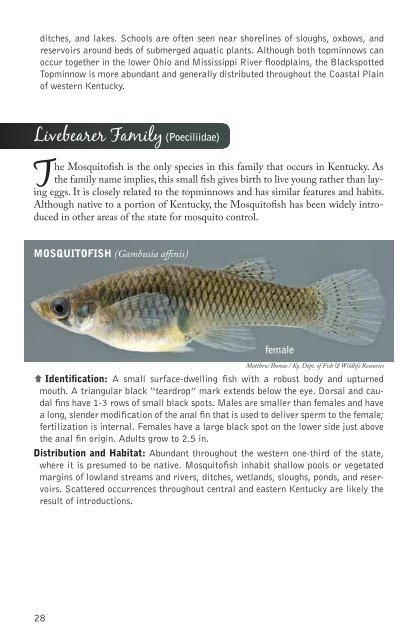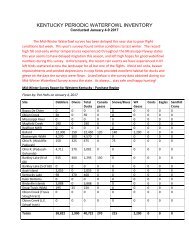Kentucky Fishes
kyfishid[1]
kyfishid[1]
- No tags were found...
Create successful ePaper yourself
Turn your PDF publications into a flip-book with our unique Google optimized e-Paper software.
ditches, and lakes. Schools are often seen near shorelines of sloughs, oxbows, and<br />
reservoirs around beds of submerged aquatic plants. Although both topminnows can<br />
occur together in the lower Ohio and Mississippi River floodplains, the Blackspotted<br />
Topminnow is more abundant and generally distributed throughout the Coastal Plain<br />
of western <strong>Kentucky</strong>.<br />
Livebearer Family (Poeciliidae)<br />
The Mosquitofish is the only species in this family that occurs in <strong>Kentucky</strong>. As<br />
the family name implies, this small fish gives birth to live young rather than laying<br />
eggs. It is closely related to the topminnows and has similar features and habits.<br />
Although native to a portion of <strong>Kentucky</strong>, the Mosquitofish has been widely introduced<br />
in other areas of the state for mosquito control.<br />
Sculpin Family (Cottidae)<br />
Two species of sculpin occur in <strong>Kentucky</strong>, both of which inhabit upland streams<br />
having cool, clear water. Sculpins are very distinctive fish, with a large, flattened<br />
head, big mouth, and tapering, scaleless body. Despite their small size, sculpins are<br />
benthic (bottom-dwelling) predators capable of consuming prey of various sizes,<br />
including aquatic insects, crayfish, small fish, and even other sculpins!<br />
MOTTLED SCULPIN<br />
(Cottus bairdii)<br />
MOSQUITOFISH (Gambusia affinis)<br />
female<br />
Matthew Thomas / Ky. Dept. of Fish & Wildlife Resources<br />
Ç Identification: A small surface-dwelling fish with a robust body and upturned<br />
mouth. A triangular black “teardrop” mark extends below the eye. Dorsal and caudal<br />
fins have 1-3 rows of small black spots. Males are smaller than females and have<br />
a long, slender modification of the anal fin that is used to deliver sperm to the female;<br />
fertilization is internal. Females have a large black spot on the lower side just above<br />
the anal fin origin. Adults grow to 2.5 in.<br />
Distribution and Habitat: Abundant throughout the western one-third of the state,<br />
where it is presumed to be native. Mosquitofish inhabit shallow pools or vegetated<br />
margins of lowland streams and rivers, ditches, wetlands, sloughs, ponds, and reservoirs.<br />
Scattered occurrences throughout central and eastern <strong>Kentucky</strong> are likely the<br />
result of introductions.<br />
Ç Identification: A small, robust fish with a large head and mouth, large fan-shaped<br />
pectoral fins, and tapering body. Color is brown with dark brown saddles on the<br />
back, extending on to the sides as bars, which are often obscured by brown to black<br />
mottling. Males in breeding condition have a red band along the margin of the first<br />
dorsal fin with a black band at the base. In <strong>Kentucky</strong>, adults grow to about 5 in.<br />
Distribution and Habitat: Occupies rocky-bottomed riffles of clear, cool, upland<br />
headwater streams from the <strong>Kentucky</strong> River eastward. A single record is also known<br />
from the West Fork Red River in Christian County.<br />
BANDED SCULPIN<br />
(Cottus carolinae)<br />
Matthew Thomas / Ky. Dept. of Fish & Wildlife Resources<br />
Matthew Thomas / Ky. Dept. of Fish & Wildlife Resources<br />
Ç Identification: Similar to the Mottled Sculpin, but with more prominent bars on<br />
the sides, which are darker at the edges and not obscured by brown to black mottling.<br />
Unlike the Mottled Sculpin, breeding males do not develop a red band at the margin<br />
of the dorsal fin with a black band at the base. Adults grow to about 7 in.<br />
Distribution and Habitat: Common in spring-fed creeks and upland streams with<br />
rocky bottoms from the lower Cumberland River (Land Between the Lakes) eastward<br />
to the <strong>Kentucky</strong> River drainage. Co-occurrence with the Mottled Sculpin is uncommon<br />
in the <strong>Kentucky</strong> River and West Fork Red River (Cumberland River) drainages.<br />
28 29



